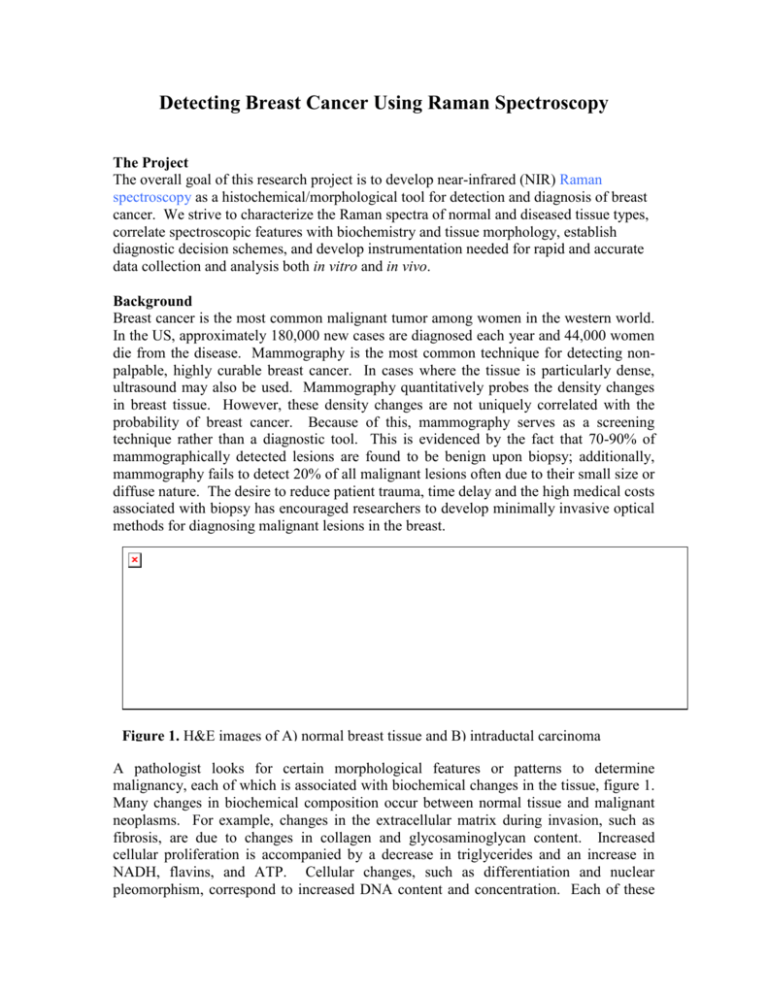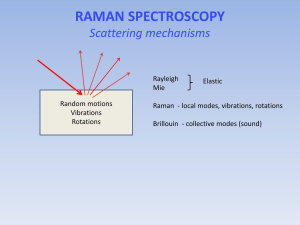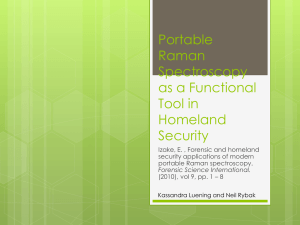Detecting Breast Cancer Using Raman Spectroscopy
advertisement

Detecting Breast Cancer Using Raman Spectroscopy The Project The overall goal of this research project is to develop near-infrared (NIR) Raman spectroscopy as a histochemical/morphological tool for detection and diagnosis of breast cancer. We strive to characterize the Raman spectra of normal and diseased tissue types, correlate spectroscopic features with biochemistry and tissue morphology, establish diagnostic decision schemes, and develop instrumentation needed for rapid and accurate data collection and analysis both in vitro and in vivo. Background Breast cancer is the most common malignant tumor among women in the western world. In the US, approximately 180,000 new cases are diagnosed each year and 44,000 women die from the disease. Mammography is the most common technique for detecting nonpalpable, highly curable breast cancer. In cases where the tissue is particularly dense, ultrasound may also be used. Mammography quantitatively probes the density changes in breast tissue. However, these density changes are not uniquely correlated with the probability of breast cancer. Because of this, mammography serves as a screening technique rather than a diagnostic tool. This is evidenced by the fact that 70-90% of mammographically detected lesions are found to be benign upon biopsy; additionally, mammography fails to detect 20% of all malignant lesions often due to their small size or diffuse nature. The desire to reduce patient trauma, time delay and the high medical costs associated with biopsy has encouraged researchers to develop minimally invasive optical methods for diagnosing malignant lesions in the breast. Figure 1. H&E images of A) normal breast tissue and B) intraductal carcinoma A pathologist looks for certain morphological features or patterns to determine malignancy, each of which is associated with biochemical changes in the tissue, figure 1. Many changes in biochemical composition occur between normal tissue and malignant neoplasms. For example, changes in the extracellular matrix during invasion, such as fibrosis, are due to changes in collagen and glycosaminoglycan content. Increased cellular proliferation is accompanied by a decrease in triglycerides and an increase in NADH, flavins, and ATP. Cellular changes, such as differentiation and nuclear pleomorphism, correspond to increased DNA content and concentration. Each of these changes, or possibly a combination of these changes, may provide a spectral marker for identifying pre-malignant lesions and malignant tumors in biological tissue using Raman spectroscopy. With an appropriate model, Raman spectroscopy can provide quantitative biochemical and morphological information about tissue composition in situ comparable to the information used by a pathologist.1-2 We have previously shown that using a combination of principal component analysis and logistic regression one can distinguish between benign and malignant tumors based on the samples macroscopic Raman spectrum.3 However, the chemical basis for this differentiation remains unknown. Using our confocal Raman microscope, we are able to collect spectra from individual morphological features. Using this system, we have recently developed a morphological model, shown in figure 2, in an effort to determine the features responsible for the spectral differentiation between benign and malignant breast lesions.4 This model fits macroscopic tissue spectra with a linear combination of basis spectra derived from Cell cytoplasm Intensity (a.u.) Cell nucleus Fat -carotene Collagen Calcium hydroxyapatite Calcium oxalate Cholesterol-like 600 800 1000 1200 1400 1600 1800 Raman shift (cm-1) Figure 2. Raman morphological model of breast tissue spectra of the cell cytoplasm, the cell nucleus, fat, -carotene, collagen, calcium hydroxyapatite, calcium oxalate dihydrate, and cholesterol-like lipid deposits. Each basis spectrum represents data acquired from multiple patients and, when appropriate, from a variety of normal and diseased states. Modeling is based on the assumptions that the Raman spectrum of a mixture is a linear combination of the spectra of its components and that signal intensity and chemical concentration are linearly related. Least-squares fitting of the macroscopic Raman spectrum of tissue yields the contribution of each basis spectrum to the entire tissue spectrum. To understand the relationship between a tissue sample’s Raman spectrum and its disease state we examine the contribution of each basis spectrum to a variety of pathologies. Intensity (a.u.) Intensity (a.u.) Intensity (a.u.) Intensity (a.u.) Intensity (a.u.) Fits of normal, benign, and malignant samples of breast tissue are shown in figure 3. Using the morphological model, the spectral features Normal: of a range of tissue samples 83% Fat can be explained in terms of 1% Collagen each sample’s morphological 0% Cell nucleus 0% Cell cytoplasm composition. The fit 10% Cholesterol-like coefficients given by the 2% -carotene 3% Calcium Hydroxyapatite model normalized to sum to one, represent percentage contributions of chemicals 600 800 1000 1200 1400 1600 1800 and morphological features to Raman shift (cm-1) the bulk tissue spectrum. As expected from pathology, Fibrosis: when we analyze the fit 49% Fat coefficients of the normal 32% Collagen Fibrous + Cysts: 0% Cell nucleus sample, it is primarily 4%2% FatCell cytoplasm composed of fat. The sample 60.5% 14%Collagen Cholesterol-like 0%2% Cell nucleus diagnosed as fibrosis, a -carotene 15% Cell cytoplasm 1% Calcium Hydroxyapatite benign condition 16% Cholesterol-like 4% -carotene characterized by scarring, 4.5% Calcium Hydroxyapatite 600 800 1000 1200 1400 1600 1800 exhibits an increase in the 600 800 1000 1400 1800 -1) 1600 Raman1200 shift (cm amount of collagen present. Raman shift (cm-1) Again, the composition is consistent with pathology as Adenosis: scar tissue is formed through Fibroadenoma: 48% Fat 26% FatCollagen 23% collagen accumulation. 16% 2%Collagen Cell nucleus Furthermore, the 5%8% Cell nucleus Cell cytoplasm 31% Cell cytoplasm fibroadenoma and malignant 14% Cholesterol-like 15% 3%Cholesterol-like -carotene samples both have a large 0%2% -carotene Calcium Hydroxyapatite cell cytoplasm content 7% Calcium Hydroxyapatite because they are pathologies 600 800 800 1000 1000 1200 1200 1400 1400 1600 1600 1800 600 1800 which exhibit cellular Ramanshift shift (cm (cm-1-1)) Raman proliferation. Infiltrating Ductal Carcinoma: 2% Fat 40% Collagen 5% Cell nucleus 34% Cell cytoplasm 19% Cholesterol-like 0% -carotene 0% Calcium Hydroxyapatite Intensity (a.u.) We are currently in the process of collecting a library of bulk Raman data in order to assess the ability of the morphological model to predict breast tissue disease state. 600 800 1000 1200 1400 1600 1800 Raman shift (cm-1) Figure 3. 2.Examples of morphological with corresponding Figure Examples of morphological fits to fibrosisfits + cysts, fibroadenoma, and ductal carcinoma with–corresponding fit(residual contributions.plotted • Data – Model fit fit infiltrating contributions. • Data Model fit below). (residual plotted below). REFERENCES 1) Manoharan R, Baraga JJ, Feld MS, “Quantitative histochemical analysis of human artery using Raman spectroscopy”, J. Photochem. Photobiol. 16: 211-233 1992. 2) Hanlon EB, Manoharan R, Koo TW, Shafer KE, Motz JT, Fitzmaurice M, Kramer JR, Itzkan I, Dasari RR, Feld MS, “Prospects of in vivo Raman spectroscopy”, Phys. Med. Biol. 45: R1-R59 2000. 3) Manoharan R, Shafer K, Perelman L, Wu J, Chen K, Deinum G, Fitzmaurice M, Myles J, Crowe J, Dasari RR, Feld MS, “Raman spectroscopy and fluorescence photon migration for breast cancer diagnosis and imaging”, Photochem. Photobiol. 67(1): 15-22 1998. 4) Shafer-Peltier K, Haka AS, Fitzmaurice M, Crowe J, Dasari RR and Feld MS “Raman microspectroscopic model of human breast tissue: implications for breast cancer diagnosis in vivo”, J. Raman Spectrosc. in press. RESEARCH GROUP Core-Investigator: Michael S. Feld PhD Graduate Studen: Abigail S. Haka Collaborators: Joseph Crowe MD, Cleveland Clinic Foundation, Maryann Fitzmaurice MD, University Hospitals Cleveland/Case Western Reserve University







